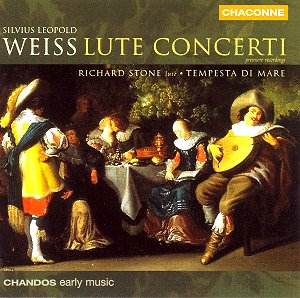If one looks at the
work-lists of composers of the 17th
and 18th centuries, one word frequently
appears: "lost". Nobody knows how many
compostions from the baroque era have
disappeared, but considering the demand
for music and the disasters which caused
compositions to be destroyed, the number
must be considerable. From time to time
compositions thought to be lost are
rediscovered, but in many cases one
has to accept that they are lost forever.
Often that is a shame, but in the case
of the most brilliant composers the
thought that potential masterpieces
have disappeared forever is almost unbearable.
Sometimes compositions have been handed
down in incomplete form. In that case
an attempt can be made to reconstruct
what is missing. Since composing was
under strict rules in pre-romantic times,
often it is not that difficult to fill
in the missing parts. But the more that
is lacking the harder it gets. This
disc presents six pieces for instrumental
ensemble by Weiss, which have been reconstructed
by Richard Stone.
Silvius Leopold Weiss
is exclusively associated with the lute.
Having learnt to play the instrument
from his father he became an extremely
successful lutenist. In 1706 he entered
the service of Count Carl Philipp of
the Palatinate. From 1710 to 1714 he
went to Italy, where he stayed mainly
in Rome and worked with the Scarlattis.
After his return he became associated
with the court in Dresden, where in
1718 he was officially appointed to
the chapel. Here he became one of the
most distinguished musicians: in 1744
he was the highest paid instrumentalist
at the court. Apparently he didn't only
perform as a soloist, but also in ensembles.
During his membership of the chapel
he had several opportunities to travel
through Europe. He visited Prague in
1717 and 1719 and again, this time with
such distinguished players as Quantz
and Carl Heinrich Graun, in 1723, Vienna
in 1718, Munich in 1722 (with Buffardin,
one of Europe's best flautists) and
Berlin in 1728 (with Quantz, Buffardin
and the violinist Pisendel). He also
was much in demand as teacher; among
his pupils are Falckenhagen and Kropfgans.
His compositions are
exclusively written for the lute. Of
no other composer of lute music are
so many compositions known.
Like Bach, who greatly
admired Weiss and arranged some of his
music, he was a representative of the
'goûts-réünis', mixing
French and Italian elements.
This disc concentrates
on an aspect of Weiss's compositional
output that has been neglected so far:
his pieces for instrumental ensemble.
The problem is that none of these works
have survived complete; only the lute
parts are extant. "Richard Stone has
reconstructed the flute and bowed-string
parts heard on this recording by using
motifs drawn from the lute part where
appropriate, and by studying concerted
works by composers whose music Weiss
would have known", Douglas Alton Smith
writes in the liner notes.
It is no doubt a huge
undertaking to reconstruct all the parts
needed to make these compositions sound
like real ensemble pieces. In the end
it is difficult to tell what part of
this music is by Weiss and what by Stone.
If the music on this disc isn't always
very interesting, who of these two is
to blame?
The best compositions
are the first two items, the Concerto
in C in Vivaldian style, and the Concerto
in d minor, which follows the pattern
of the 'sonata da chiesa', perhaps written
under the influence of Corelli's sonatas.
Another rather good work is the Concerto
in F for lute and strings. The main
weaknesses are the concertos for lute
and transverse flute. They have their
moments too, like the first two movements
of the Concerto in F, but they are followed
by an 'amoroso' and an allegro, which
dwell too long on thematic material
that isn't very interesting. The same
is true for the last item, the Concerto
in B flat.
In the Concerto grosso
in B flat the 'concertino' is played
by lute, transverse flute, violin, viola
da gamba and cello, which is a rather
unusual combination. There are some
nice passages here, but as a whole it
is one of the less convincing items
on the programme.
If the music isn't
always as engaging as one would hope
this is certainly not due to a lack
of commitment by the players. Both Richard
Stone and Gwyn Roberts, who play the
central role on this disc, do an excellent
job; and so do their colleagues. One
of the highlights is the Concerto in
d minor, which is played with verve
and passion. The first movement (largo)
is very expressive. The allegro which
follows it is brisk and sprightly, played
with a very differentiated articulation
and a nice forward drive from the cello.
The question remains:
does it make sense to reconstruct compositions
of which so little original material
has survived? Do we get a better picture
of Weiss as a composer? In the end all
these compositions are speculative:
this is how they could have sounded.
But nobody knows for sure. The thought
that compositions of brilliant composers
are lost is almost unbearable but there
is nothing we can do than accept it
as a fact of life.
Johan van Veen


